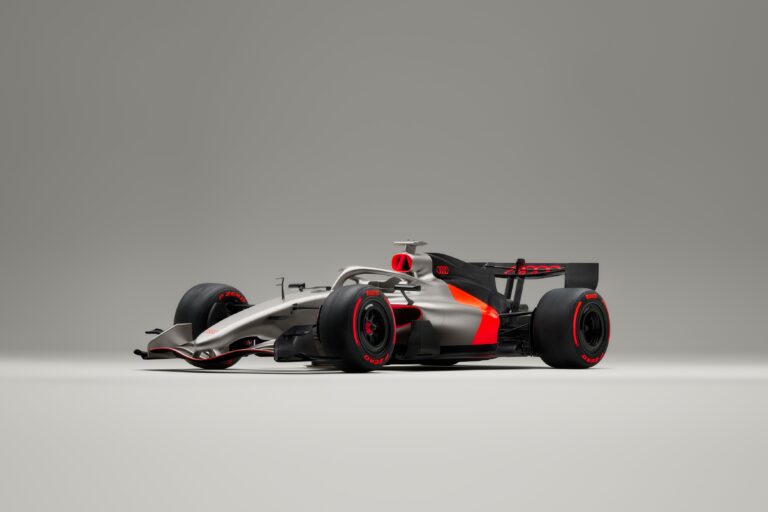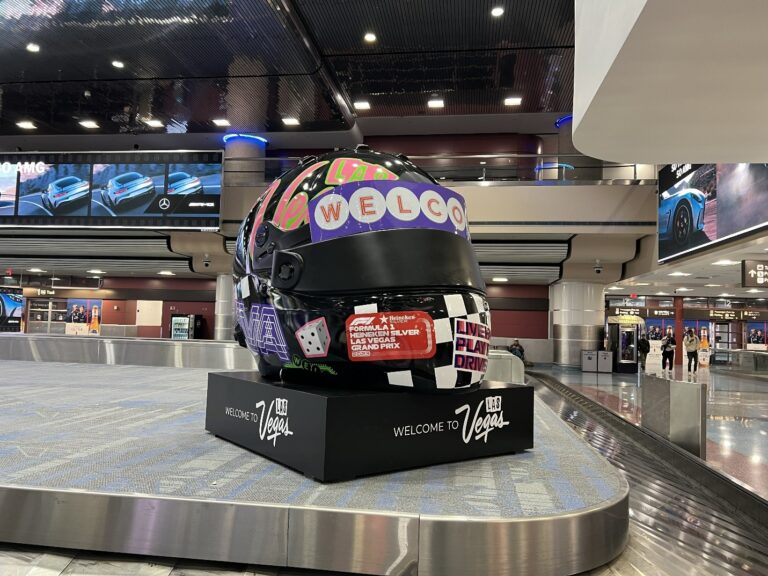Paddock Magazine had the chance to speak exclusively with Robin Fenwick, Founder & CEO at Right Formula, the renowned sports marketing agency in Formula 1. Robin is not just one of the best business leaders in the paddock; he also has an excellent personality and a massive amount of knowledge about the sport and its business side.
Robin Fenwick started his sporting journey at Durham University, where he tried his hand (unsuccessfully) at becoming a professional sportsman. Eventually, he decided that a career in the sports business was the right path for him, working for a handful of small agencies before receiving the call to join McLaren.
After managing various McLaren partnerships, including its Title Partnership with West, he was approached by Hilton to manage its sporting sponsorships. Robin then noticed a gap in the market for agencies, after working with a few that were more operational and didn’t have the in-depth knowledge required or relationships needed in the sport.
Hence, the creation of Right Formula. And Robin’s first client? Hilton!
With your massive background in both agency work and in-house roles, how do you navigate the dynamics between client expectations and agency capabilities at Right Formula?
Firstly, it’s important to say that Right Formula has been set up as a 360-degree agency. We believe we can deliver anything that clients are asking for through the lens of Formula 1 partnerships. The business was set up to be the best, not the biggest. We have gone out and tried to secure the best-in-class people related to strategy, creative, digital, communications, hospitality and events, graphic design, and video production.
This allows us to ensure that whatever our client’s needs are, they’re fulfilled at the right level. Now, it won’t surprise you to know that clients, particularly when spending a lot of money on the sport, have high expectations. Sometimes we need to manage those expectations, but the way in which we manage that process is by identifying what success looks like and explaining what is achievable. We then define a very clear scope of work between us together with KPIs and then apply people with the right skill set and experience to deliver against the desired outcomes. We sign off on that and then regularly review and optimize the approach to deliver the best results. We ensure that we’re always listening to our clients, but as importantly, we’re looking at the data and advising accordingly.
There may be areas we’re focusing on, but they’re not making a big enough impact for our clients in a positive way, so we may need to change the direction, or it could be that we are making a very positive impact, and we may want to double down in that area by spending more money or time in that particular area. That recipe has worked well for us over the last 15 years, and businesses like Hilton Hotels have been with us for the whole journey.
SAP has been with us for 12 years, and Pirelli have been with us for 10 years. I’m proud of this because those big brands will have been approached a number of times by very competent competitors over the years. However, they have stuck with us.
How important is innovation in sports marketing today? Are there any new technologies or strategies that you’re particularly excited about?
I would say that before Covid, the lion’s share of the work that we were undertaking was focused on hospitality and events. However, the focus for us today is much more geared toward the strategy, creative, digital, content and communications. This is not to say that the hospitality and live experiences haven’t come back, but we have built various capabilities that perhaps we wouldn’t have considered in the past – even when I think simply about digital there is a huge variety of services, whether it’s paid media, e-commerce, email marketing, web or product development, there are so many different angles we need to provide services for.
It’s really making sure that we’ve got the right people that are able to deliver the results that our clients are asking for. Even areas like building virtual events and conferences, podcasts, webinars etc. – these types of activities weren’t such a focus before; we’ve seen a real rise in those and to make sure that we are seen as ‘best in class’ means we need to recruit the best talent. We try to do everything in-house, that allows us to be agile and create an environment where our clients can get their best results in the shortest period of time.
Research and Insights is another area we’ve expanded significantly on over the last few years; not only do we buy in a lot of data and research, but we generate our own too; this allows us to make informed decisions. Alongside that, we also have to look at other trends and areas of interest for our clients. Sustainability and DE&I have become popular topics as some partners want to implement activities associated with those areas.
Could you share a memorable campaign or project that Right Formula has been involved in recently, and what were the main challenges and successes?
I could name a few and I’ll start with one, which was the launch of a new partnership, THG with Williams Racing.
The launch focused on Myprotein, THG’s fitness and health brand where we were tasked with coming up with something extremely disruptive. We came up with the idea of putting a monster truck on the racetrack in Austin, Texas. We painted it in Williams colours with Myprotein branding, this was unveiled on track at the US Grand Prix with the tagline of ‘Everything is bigger in Texas’. As you can imagine, it had its complexities trying to do that on a Thursday before a race weekend given THG had a partnership with the Williams F1 team, not a collaboration with Formula 1 the series, so we had to get access and assets that they didn’t otherwise have, and therefore some negotiations were required with Formula 1 directly.
The decision to undertake this activity was made approximately a week in advance of the event and my belief is that many businesses wouldn’t have taken this on. But as long as we felt we could deliver a high-quality result, we wanted to make it happen. It did mean we had to work extremely quickly, but ultimately we needed to ensure it delivered the right results. I’m delighted we managed to achieve this with a relatively low budget especially as it had a very high impact in terms of the media coverage it generated.
Another campaign involved our client ExxonMobil asking us to come up with an idea for their new ‘99 fuel’ they had coming to the market. We came up with two ideas; one was using the 99 ice cream vans we have here in the UK, where the two Red Bull drivers raced against each other whilst the Sky Sports team provided some fun commentary. The second was using the 99 red balloons song where Max Verstappen and Sergio Perez were given helmets with spikes on; they then had to drive go karts and pop as many balloons as possible in the time allowed. Both pieces created great content and generated a huge amount of media coverage.
I would also reference Hilton and McLaren. I mentioned that they have been in partnership for 20 years this year, so we’ve developed a range of initiatives for them over the years. One was ‘A night at McLaren’, which was held at the Team’s headquarters, the McLaren Technology Centre (MTC). We brought in approximately 30 beds which were used during the course of the Australian Grand Prix for Hilton Honors members (Hilton’s loyalty programme) to sleep in specially created hotel rooms at the MTC, where they watched a few Formula 1 themed films the night before, and then the Grand Prix in the morning whilst being given gifts and goodies. It was a big loyalty programme play, so they were really engaging their members, who could use their points to bid to attend that unique event.
Right Formula has a strong presence in motorsport and beyond. How do you balance specialisation with diversification in your client portfolio?
I would say the percentage of work that we do in Formula 1, compared to other sports, has changed over the years quite dramatically, so in the early days, we focused almost exclusively on Formula 1 because we felt that we couldn’t be all things to all sports. We didn’t want to be spread too thin; we were willing to focus our eggs in one basket.
As the years moved on, that proved very successful for us and for the first four to six years, we were doubling every year we existed. In fact, in the fourth year, we quadrupled in size, and that meant that we became the sixth fastest-growing private company in the UK. However, as it got to 2015 and 2016, the health of Formula 1 was not as it is today, and it was our fundamental objective to try and diversify into other sports. We have worked in football, golf, sailing, cricket, rugby, tennis, to name a few, and I would say we got down to a point where it was probably 50% motorsport and 50% other sports.
However, more recently, the percentage of focus on Formula 1 has probably gone back up to about 70% of our work due to the interest in working with us from the many new brands that have entered the sport. We try not to take on any work we don’t feel we can do a fantastic job on because our reputation is more important to us than revenue. It’s something we say an awful lot within the business, and as part of the objectives that we’re setting ourselves. Of course, we want to grow, but we want to do so in a sustainable way, and I think if you look at the world of Formula 1 today, it actually makes up 6.6% of the revenue of all global sponsorships, which is enormous and is one of the very few truly global sports at the scale that they operate within.
Now, we’re fortunate in that we’re in a position where we look after over 30 brands in the world of Formula 1. That’s more than any of our close competitors. We look after a number of series level partners such as Pirelli, Qatar Airways, Globant, Allwyn and Aggreko. We also work with team partners across the paddock, such as Oracle and ExxonMobil with Red Bull Racing and Hilton, Dropbox, Airwallex and Ecolab at McLaren.
When it comes to sponsorship, the return on investment is often a key concern for brands, let’s say. How does Right Formula measure and demonstrate the value of sponsorship investments to your clients?
Every client is different. First and foremost, we have invested significantly in our strategy team. We’ve invested considerably in our research and insights team, and together, every partnership that we start with, we begin with a framework; I call it the architects’ plans, and it’s critical that we have this. If we’re going to build the house, you wouldn’t go and make a house without the plans first. Once we understand what the desired outcomes of the business are, we also need to look at where are the important geographies, we need to look at who the customer and personas are, we need to look at the brand values, we need to look at their products and services, and any other components in and around their business that may influence the plan that we create.
We would then create that plan, set KPIs as quantifiable as possible, and then measure that throughout the course of the year. This is not just looking at the media value that is generated but being more sophisticated in trying to understand who you are trying to reach and how you are reaching them.
We also need to think about how that follows through into the next stage, which is consideration of your product in question, and then run through to ultimately sales and retention of those customers. We will put metrics in place at every step of the journey to measure that, and this might include measuring sentiment analysis or putting a brand tracker in place and following the activity.
Looking ahead, what are your predictions for the future of sports marketing, especially in the context of evolving consumer behaviours and global trends?
Well, it’s very encouraging that we’ve seen an increase in the female audience; this is one of the fastest-growing sectors of F1’s fan base. The female audience is now 41% of the overall fan base from the low 30s. What’s even more interesting is that the fastest-growing sector within that fan base is 16- to 24-year-olds.I’m delighted that we have a new generation of consumers and fans joining the sport and I think there are programmes like F1 Academy to thank for that.
If I look at the last year or two, the likes of Qatar Airways or LVMH coming into the sport, I would have questioned whether they would have considered coming into the sport maybe 5 to 10 years ago. But to say that LVMH are reportedly spending in excess of 100 million a year, and they have signed for 10 years, is an incredible commitment, one that I didn’t think I would necessarily see in my lifetime. We’ve also seen other businesses enter the sport, particularly in the financial sector. Aside from the crypto sector increasing, we’ve seen the likes of MasterCard, Visa, Amex, Santander and UniCredit, which has been fascinating.
We’ve seen a range of new tech businesses come in like HP, Dropbox, IBM, Globant, and then some unusual sectors, but really interesting big businesses, like Ecolab and Allwyn, that have been really impressive.
Working with such an array of different businesses is really fascinating to me because they, in turn, are also attracting new audiences to the sport. Therefore, I think we will continue to see growth in Formula 1. I mean, it’s now valued at 22 billion dollars and seems to be going upwards almost on a regular basis.
But Formula 1 has to keep on its toes, not rest on its laurels, and keep up with some of the latest new trends. There are some continual questions about things like sustainability or diversity within sports that F1 is making great strides towards, but collectively we could always do more.









